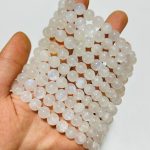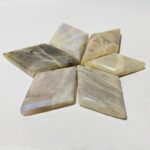Introduction
Peruvian opal, a mesmerizing gemstone, exudes a captivating charm that has enchanted civilizations for centuries. Originating from the rugged mountains of Peru, this ethereal stone showcases a vibrant play of colors that dance upon its surface, making it a mesmerizing sight. Its captivating allure has earned it a place among the most coveted gemstones, coveted by collectors and artisans alike.

Discovery and History
The history of Peruvian opal dates back to ancient times, with evidence suggesting its use by indigenous cultures in Peru. The Incas, an advanced civilization that ruled the region centuries ago, revered the opal as a symbol of fertility and good fortune. They believed that its iridescent colors represented the divine powers of nature. Spanish conquistadors later discovered this precious stone and brought it to Europe, where it quickly gained recognition for its exquisite beauty.
Geological Formation
Peruvian opal is a unique gemstone formed when silica-rich water seeps into volcanic cavities and solidifies over millions of years. The result is a porous matrix that traps water droplets, creating the mesmerizing play of colors known as opalescence. The unique geological conditions found in the high Andes of Peru give rise to the exceptional brilliance and color variations of Peruvian opal.
Properties
1. Composition and Hardness
Peruvian opal is composed primarily of hydrated silica (SiO2·nH2O), with a hardness rating of 5.5 to 6.5 on the Mohs scale. This moderate hardness makes it durable enough for use in jewelry, but requires careful handling to avoid scratches or breakage.
2. Color and Opalescence
The most distinctive feature of Peruvian opal is its vibrant opalescence, a phenomenon that causes it to emit a rainbow of colors as light interacts with its internal structure. Unlike common white opals, Peruvian opal exhibits a kaleidoscopic array of colors that range from fiery reds and oranges to ethereal blues and greens.
3. Fluorescence and Phosphorescence
Under ultraviolet light, Peruvian opal exhibits both fluorescence and phosphorescence. Fluorescence refers to the emission of visible light while exposed to UV rays, while phosphorescence denotes the continued emission of light after the UV source has been removed. These properties enhance its allure and make it a captivating spectacle in low-light conditions.
Extraction and Processing
Peruvian opal is primarily extracted from the La Victoria opal mines located in the Andes Mountains. The mining process involves using heavy machinery to remove overburden and expose the opal-bearing rock formations. Once extracted, the opal is subjected to a meticulous cleaning and cutting process to reveal its captivating colors.
Value and Price Factors
The value of Peruvian opal is determined by several key factors, including:
1. Color and Pattern
The intensity and diversity of colors play a significant role in the value of Peruvian opal. Specimens that showcase a wide range of vibrant hues and unique patterns command higher prices.
2. Clarity and Inclusions
The clarity and presence of inclusions within Peruvian opal also impact its value. Gemstones with few inclusions and excellent transparency are more highly prized.
3. Carat Weight
As with other gemstones, the carat weight of Peruvian opal directly influences its price. Larger specimens tend to be more valuable, especially if they maintain exceptional color and clarity.
Applications
The ethereal beauty of Peruvian opal has led to its use in a wide range of applications, including:
1. Jewelry
Peruvian opal is a popular choice for jewelry makers, owing to its mesmerizing colors and captivating opalescence. It is often used in pendants, earrings, rings, and bracelets, adding a touch of elegance and individuality to any ensemble.
2. Decorative Objects
Beyond jewelry, Peruvian opal is also used to create exquisite decorative objects, such as sculptures, figurines, and home décor items. Its iridescent colors and unique patterns lend an air of sophistication to any space.
3. Healing and Meditation
Some believe that Peruvian opal possesses therapeutic properties and is often used in healing and meditation practices. It is said to promote balance, creativity, and emotional well-being.
Alternative Applications
To harness the full potential of Peruvian opal, researchers have explored innovative applications, including:
1. Nanotechnology
The unique optical properties of Peruvian opal have sparked interest in its use in nanotechnology. Scientists are exploring its potential for applications in advanced imaging, sensing technologies, and optical filters.
2. Energy Conservation
Due to its exceptional light-emitting properties, Peruvian opal is being investigated for its potential in energy conservation. Researchers are exploring its use in energy-efficient lighting and solar energy technologies.
3. Advanced Materials
The porous structure and opalescent properties of Peruvian opal have led to its consideration for advanced materials applications. It is being investigated for its potential in lightweight composites, optical coatings, and photonic devices.
Tips and Tricks
To get the most out of your Peruvian opal, consider the following tips:
1. Proper Care and Storage
Due to its moderate hardness, Peruvian opal should be handled with care to avoid scratches or breakage. Store it in a soft, lined case or jewelry pouch to prevent damage.
2. Cleaning and Maintenance
Clean Peruvian opal using a mild detergent solution and a soft brush. Avoid harsh chemicals or ultrasonic cleaners, as they can damage the gemstone.
3. Light Exposure
Extended exposure to sunlight can cause the colors in Peruvian opal to fade over time. Limit direct sunlight exposure to preserve its vibrancy.
4. Expert Appraisal
If you possess a valuable Peruvian opal, consider obtaining an expert appraisal to determine its authenticity, quality, and value. This will protect your investment and ensure you have an accurate understanding of its worth.
Common Mistakes to Avoid
To avoid common pitfalls, keep the following in mind:
1. Overcleaning
Excessive cleaning can damage Peruvian opal. Only clean it when necessary and use a mild detergent solution.
2. Exposure to Heat
High temperatures can cause Peruvian opal to lose its water content and dull its colors. Avoid exposing it to extreme heat sources, such as ovens or direct flames.
3. Using Harsh Chemicals
Harsh chemicals, such as bleach or ammonia, can damage the surface of Peruvian opal. Always use mild detergents and avoid abrasive cleaners.
4. Rough Handling
Due to its moderate hardness, Peruvian opal can be scratched or broken if not handled with care. Avoid wearing it during strenuous activities or when handling rough objects.
Pros and Cons
Pros:
- Captivating opalescence and vibrant colors
- Unique and eye-catching gemstone
- Relatively affordable compared to other precious opals
- Versatile for use in jewelry, decorative objects, and alternative applications
Cons:
- Moderate hardness, requiring careful handling
- Can be susceptible to fading if exposed to prolonged sunlight
- May contain inclusions or imperfections that affect its value
- Sourcing genuine Peruvian opal can be challenging
Conclusion
Peruvian opal, a mesmerizing gemstone with unparalleled beauty, has captivated civilizations for centuries. Its enchanting play of colors and versatile applications make it a timeless treasure. By understanding its properties, value factors, and proper care, you can fully appreciate the allure of this extraordinary gemstone and enhance its beauty for generations to come.




























